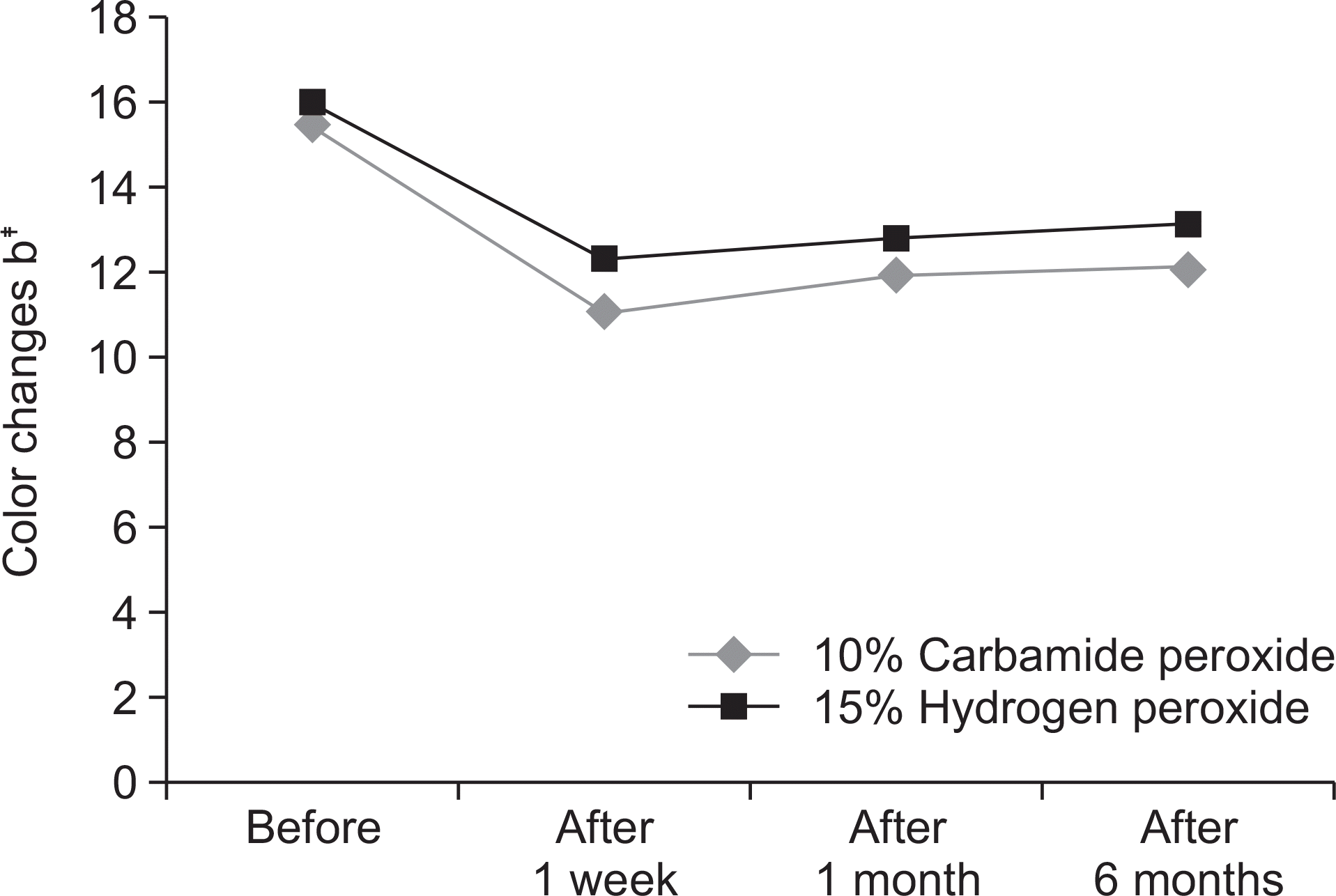Abstract
Objectives
The quest for a happy life is accompanied by an increase in social activities, living standards, and socioeconomic development, with individuals showing increased interest in health and esthetics. In the field of dentistry, not only prevention and treatment but also esthetics is gaining popularity. The aim of this study was to identify tooth color reduction and consequent patient satisfaction over a period of 6 months after office and home bleaching.
Methods
Thirty subjects were divided using the convenience sampling method into two groups based on the bleaching agent used: 10% carbamide peroxide (CP10; home bleach) and 15% hydrogen peroxide (office bleach). CP10 was used at home in a tray for 2 h/day over 14 days, while 15% hydrogen peroxide was light-activated for 15 min, three times/session (total, 45 min). A control set of teeth without any bleaching treatment was used as reference. Shade evaluation was conducted using the Shade Eye NCC at baseline, 1 week, and 1 and 6 months after bleaching. Data were analyzed using the Mann-Whitney U test and the nonparametric Friedman test.
Results
There were significant differences in tooth color before and after bleaching in both the home and office bleach groups, although intergroup differences were not observed. Although b* values after bleaching were lower than the original values, only slight tooth color reduction was observed at 6 months. ΔE*, which represents the overall change in color, at 1 and 6 months after bleaching was significantly different from that at baseline in the home bleach group, while it showed no significant differences in the office bleach group. According to a patient satisfaction survey, patient satisfaction significantly increased over time in the home bleach group, although it did not differ significantly between groups.
References
1. Kwon SR, Ko SH, Goldstein RE. Color atlas of tooth whitening. 1st ed. Seoul: Daehan Narae Publishing;2006. p. 195–202.
2. Haywood VB, Heymann HO. Nightguard vital tooth bleaching. Quintessence Int. 1989; 20:173–176.
3. Kim SK, Kang HK, Kim YK, Nam SH, Moon SJ, Min HH, et al. Conservative Dentistry. 3rd ed. Seoul: Komoonsa Publishing;2013. p. 226–240.
5. Watts A, Addy M. Tooth discoluration and staining: A review of the literature. Br Dent J. 2001; 190:309–316.
6. Kyun SR, Go SH. Bleaching techniques in restorative dentistry. Seoul: Jisung publishing;2005. p. 88–192.
7. American Dental Association. Consumer products with the ADA seal of acceptance [Internet]. Available from:. http://www.ada.org/ada/seal/adaseal_consumer_shopping.
8. Haywood VB. History, safety and effectiveness of current bleaching techniques and application of the nightguard vital bleaching techniques. Quintessence Int. 1992; 23:471–488.
9. Haywood VB. Current status of nightguard vital bleaching. Compend Conti Educ Dent suppl. 2000; 21:10–17.
10. Matis BA, Mousa HN, Cochran MA, Eckert GJ. Clinical evaluation of bleaching agents of different concentrations. Quintessence Int. 2000; 31:303–310.
11. Meireles SS, Santos IS, Della Bna A, Demarco FF. A double-blind randomized trial of two carbamide peroxide tooth bleaching agents:2-year follow-up. J Dent. 2010; 38:956–963.
12. Meireles SS, Heckmann SS, Leida FL, Santos IS, Della Bna A, Demarco FF. Efficacy and safety of 10% and 16% carbamide peri-oxide tooth whintening Gels:A randomized clinical trial. J Opdent. 2008; 33:606–612.
13. Türkün M, Sevgican F, Pehlivan Y, Aktener BK. Effect of 10% carbamide peroxide on the enamel surface morphology:A scanning electro microscopy study. J Esthet Restor Dent. 2002; 14:238–244.
14. McGrath C, Wong AH, Lo EC, Cheung CS. The sensitivity and responsiveness of an oral health related quality of life measure to tooth whitening. J Dent. 2005; 33:697–702.

15. Polydorou O, Mönting JS, Hellwig E, Auschill TM. Effect of in-office tooth bleaching on the microhardness of six dental esthetic restorative materials. Dent Mater. 2007; 23:153–158.

16. Yoon YS. Oral health and eating habit attributes relating to the maxillary anterior teeth color by using the ShadeEye NCC. J Dent Hyg Sci. 2012; 12:348–358.
17. Lenhard m. Assessing tooth color change after repeated bleaching in vitro with a 10 percent carbamide peroxide gel. J Am Dent Assoc. 1996; 127:1618–1624.
18. McLaren K. Colour space, colour scales and colour difference. McDonald R, editor. Colour physics for industry. Huddersfield: H Charlesworth & Co. Ltd.;1997. p. 97–115.
19. Sin BK, Yang SE. The evaluation of clinical efficacy and longevity of home bleaching without combined application of In-office bleaching. J Korean Acad Conserv Dent. 2010; 35:387–394.

20. Medeiros MC, Lima KC. Effectiveness of nightguard vital bleaching with 10% carbamide peroxide-A clinical Study. J Can Dent Assoc. 2008; 74:163–163e.
Table 1.
The subject's inclusion and exclusion criteria
Table 2.
Evaluation of color changes (b*, △E*) before and after tooth bleaching
| 10% CP | 15% HP | P-value* | ||
|---|---|---|---|---|
| Mean±SD | Mean±SD | |||
| b* | Before | 15.37±2.25 | 16.03±1.48 | 0.493 |
| After 1 week | 11.01±1.88 | 12.29±1.22 | 0.074 | |
| P-value** | 0.001 | 0.001 | ||
| △E* | After 1 week | 5.65±1.56 | 4.48±0.97 | 0.029 |
Table 3.
Evaluation of color changes (b*) according to period and group
| 10% CP | 15% HP | P-value* | ||
|---|---|---|---|---|
| Mean±SD | Mean±SD | |||
| b* | Before | 15.37±2.25 | 16.03±1.48 | 0.493 |
| After 1 week | 11.01±1.88a | 12.29±1.22a | 0.074 | |
| After 1 month | 11.91±2.10b | 12.76±1.40b | 0.290 | |
| After 6 months | 12.03±2.31b | 13.16±1.79b | 0.152 | |
| P-value** | 0.006 | 0.004 |




 PDF
PDF ePub
ePub Citation
Citation Print
Print



 XML Download
XML Download